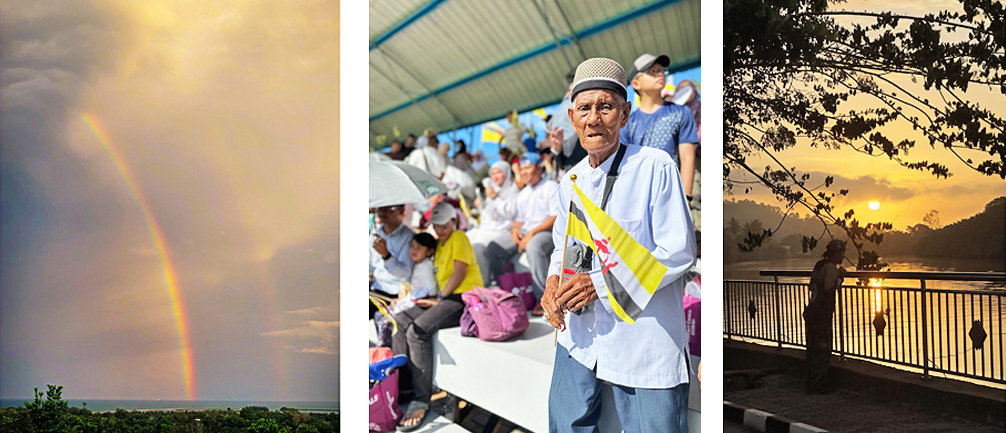Khayr Zakariyya
Your smartphone camera holds the potential to be your most valuable tool for capturing moments, simply because it is constantly by your side. When people praise mobile photography, often referred to as “phoneography”, they are typically referring to the ability to spontaneously capture unexpected scenes or events.
It could be a quirky sight, like a person in a whimsical costume commuting to work, a noteworthy encounter with a celebrity, or even that stunning sunset that takes your breath away. With your phone camera always at hand, you have the power to seize these fleeting moments and immortalise them in captivating photographs.
Dedicated local mobile photographer Zulfadli Zainuddin shared some of his insights in an interview with the Bulletin.
“Mobile photographers keep their creative instincts constantly engaged, always seeking out opportunities to capture compelling images,” said Zulfadli.
“The ability of phone photography to blend seamlessly into the surroundings allows them to document candid scenes effortlessly. As a result, mobile photographers excel at immortalising these genuine and unscripted moments in public spaces.
“It is true that many mobile phone cameras produce lacklustre photos, this limitation is easily overcome by any software or applications that can transform them into something extraordinary. This is the essence of mobile photography.”

Further comparing the use of traditional cameras and mobile phones for photography, he said, “Even if I had captured an exceptional photograph, it would have remained hidden away on my hard drive. Sure, I could have uploaded my pictures from a traditional camera to platforms like Flickr, but that involved the inconvenience of connecting cables, and going through a tedious process.”
“On the other hand, sharing photos through a mobile phone is an effortless effort. With a few taps, my photos can be instantly showcased to the world, inviting immediate feedback and engagement. This seamless and prompt sharing experience has revolutionised the way we connect and receive validation for our visual creations.”
Zulfadli added, “Mobile photographers are a significant challenge to traditional photojournalists. If something exciting happens on the street, chances are a mobile photographer is already there to capture the moment.”
He also highlighted that while citizen photojournalists may not have the same composition skills as professionals, they have the advantage of being present in the moment and can quickly publish their photos without extensive editing.
In the fast-paced world of photojournalism, mobile photographers have become intimidating competitors due to their ability to capture and share events as they happen, he added.
“One of my mentors once said, ‘You need to realise that it does not mean that if you own a good camera, you will produce stunning images or photos.’ I always believe what he said was true. Basically, it all depends on the person behind the camera. You can get good or decent photos by only using mobile camera if you know the rules of thumb for photography. We all need to learn the basic of photography. Starting with lighting, composition, focussing and colours.”
Asked about the pros and cons of mobile photography, Zulfadli said, “This has been a total discussion with all of my enthusiast photographers locally and also internationally.
“For example, it is very difficult to capture a stunning and sharp image of the Milky Way by using your phone. You need the help of photography software to enhance the photos that you took. Meanwhile, you can easily take Milky Way photography by using digital single-lens reflex (DSLR) cameras.
“I would say that fundamentally, photography is about the same things, no matter what device you use. Even so, I would say the biggest difference for me is that I have a phone with me everywhere I go. Another would be the technical limitations of smartphone cameras in particular, the lack of control of depth of field.”
Zulfadli’s advice for beginners is to try taking more photographs, with different ways of shooting on the phone, different modes, and especially the pro mode.
“The main thing is not to be lazy and to actually spend more time on your hobby. Take advantage of the convenience of mobile photography and keep your eyes open wherever you go.
“Most of my best mobile photos have been taken in completely unplanned situations; I just happened to see something interesting.
“But when you take the phone from your pocket, don’t just quickly snap a photo. Instead, take a moment to think. What is the optimal cropping? Zooming usually isn’t an option with a phone on so you may need to move a few metres. How would it look from another angle? Should I wait a few seconds for that car to move?
While his smartphone won’t be replacing a conventional camera any time soon, Zulfadli reminded that “it’s not the technology inside the camera, but the beauty outside that matters most”.
So even if you don’t have a fancy camera, don’t let that stop you from going out and experimenting with photography.







